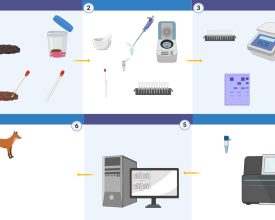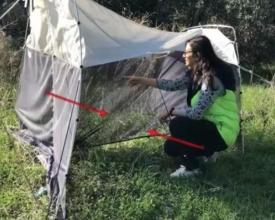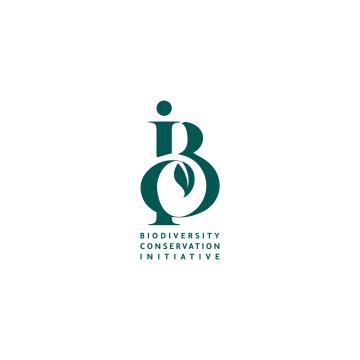
DNA Analysis of Animal Scats: A Cutting-Edge Tool for Ecological Restoration in Mount Lebanon
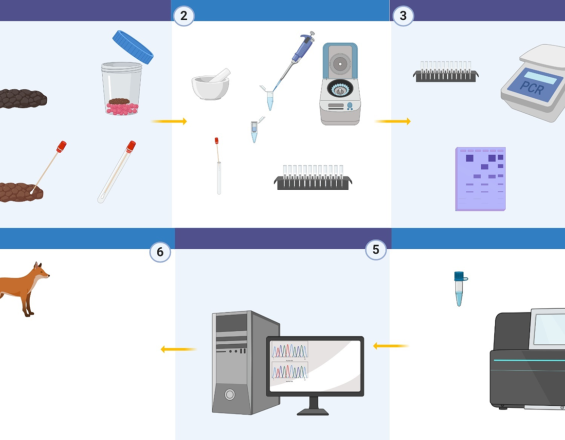
Understanding predator-prey dynamics and seasonal food web variations reveals key insights into ecosystem function. In Lebanon, a Mediterranean climate change hotspot, reforestation has traditionally relied on monocultures like pine and cedar, which limit biodiversity and resilience. A more effective approach involves planting species that support wildlife, particularly seed dispersers, to promote natural regeneration. Our solution applies DNA barcoding and metabarcoding to analyze animal scats, identifying plant species consumed and dispersed by wildlife. This reveals seed dispersal patterns and animal diets across seasons, guiding forest managers in selecting native plants that enhance ecosystem recovery. By incorporating animal-plant interactions, our approach addresses critical environmental, social, and economic challenges, improving biodiversity, forest resilience, and restoration outcomes.
Context
Challenges addressed
Our solution addresses Lebanon's urgent environmental, social, and economic challenges related to climate change impacts on natural ecosystems. As a Mediterranean climate change hotspot, Lebanon faces frequent fires, land abandonment, and biodiversity loss, weakening forest resilience. Conventional reforestation, focused on pines and cedars, lacks biodiversity and fails to support wildlife essential for natural regeneration. The project diversifies reforestation by selecting native plants that attract and support wildlife, creating self-sustaining, climate-resilient forests. Socially, degraded forests impact communities by reducing vital ecosystem services like water regulation and soil stability. Restoring biodiversity strengthens these services, benefiting communities and fostering a closer connection to local nature. Economically, healthier, biodiverse forests lower future restoration costs, enhance ecotourism potential, and create sustainable income opportunities.
Location
Process
Summary of the process
Our solution’s success stems from six interconnected building blocks. Advanced DNA barcoding and metabarcoding techniques provide accurate, noninvasive biodiversity data. This is supported by Lebanon’s first open-access reference library of native species, now expanding to insects, birds, and fungi. Strategic partnerships with the Smithsonian, iBOL, and Saint Joseph University ensure scientific rigor and regional leadership. Field and lab protocols are tailored to local ecological conditions, enhancing data relevance. Collaboration with ministries, NGOs, and practitioners translates findings into policy and restoration practice, while awareness campaigns foster community engagement. Finally, capacity-building programs funded by BBI-CBD train regional conservationists, democratizing molecular tools and ensuring long-term sustainability. Together, these elements create a scalable, science-based framework for effective biodiversity restoration in climate-vulnerable Mediterranean ecosystems.
Building Blocks
Localized Reference Library Development
The creation of a comprehensive, open-access DNA reference library of native plant and animal species was foundational to our solution. Recognizing that global databases lacked coverage for many Eastern Mediterranean species, we built the first Lebanese library encompassing plants, mammals, and now expanding to insects, birds, and fungi. This reference database improves the accuracy of DNA sequence matching and enables precise identification of species present in environmental samples. It also fills a critical regional data gap and facilitates ecological studies, biodiversity monitoring, and conservation planning. By publishing the library openly, we promote transparency, collaboration, and the potential for adaptation in similar biodiversity hotspots.
Enabling factors
Strong institutional support from Saint Joseph University, collaboration with local taxonomists, and access to specimens were vital. Funding from initial grants allowed sequencing efforts. Commitment to open data principles ensured broad accessibility. Support from iBOL facilitated integration into global databases, enhancing utility and visibility.
Lesson learned
Building a reliable reference library requires significant coordination between molecular scientists and taxonomists. Accurate species identification depends heavily on quality-verified voucher specimens and metadata. The process is time-consuming but indispensable for meaningful metabarcoding results. Sharing the library openly generated interest and collaboration but also highlighted the need for continuous updates and expansion to cover more taxa. Engaging local experts fostered ownership and increased the scientific credibility of the data, ensuring the library’s sustainability as a national resource.
Advanced DNA Barcoding and Metabarcoding Techniques:
DNA barcoding and metabarcoding are cutting-edge molecular techniques that allow precise identification of species from small biological samples such as animal scats. Barcoding targets a single species by sequencing a standard gene region, while metabarcoding amplifies multiple DNA markers simultaneously, enabling comprehensive analysis of complex mixtures. These methods provide detailed insights into animal diets, predator-prey relationships, and seed dispersal patterns without invasive sampling. In our solution, these techniques were adapted to the Lebanese ecological context, enabling high-throughput biodiversity assessment and revealing key interactions between fauna and flora. This approach overcomes limitations of traditional ecological surveys and opens new possibilities for monitoring biodiversity changes, especially in regions with scarce baseline data.
Enabling factors
Access to high-throughput sequencing technology, expertise in molecular biology, and the availability of regional reference libraries enabled successful implementation. The collaboration with international experts, such as the Smithsonian Institution, ensured methodological rigor. The development of protocols tailored to local conditions and sample types was crucial for reliable results. Funding from FERI and MEPI provided the necessary resources to establish and scale the molecular workflows.
Lesson learned
We learned that customizing DNA metabarcoding protocols to local ecological conditions is essential to maximize data accuracy. Establishing comprehensive reference libraries beforehand is critical for correct species identification. Early engagement with molecular experts and international partners accelerated technology transfer and improved quality control. We also discovered that noninvasive sampling methods, such as scat collection, can yield rich data but require strict protocols to avoid contamination. Finally, integrating these molecular tools with traditional ecological knowledge strengthens interpretation and practical application for restoration.
Strategic International and Academic Partnerships
Partnerships with the Smithsonian Institution, iBOL, and Saint Joseph University have been central to our project’s success. The Smithsonian provided advanced expertise in metabarcoding methodology and quality assurance, enabling rigorous application of DNA analysis. iBOL supports the expansion of barcoding efforts, particularly for insects, linking our regional data to global biodiversity initiatives. Saint Joseph University leads research implementation and capacity building, ensuring regional ownership and continuity. These collaborations combine global knowledge with local ecological and institutional context, enabling innovation and scalability.
Enabling factors
Long-term collaborative relationships, shared scientific goals, and mutual trust were key. International funding and technical assistance fostered knowledge exchange. The presence of a dedicated local research team facilitated communication and implementation. Shared commitment to open data and capacity building strengthened partnerships.
Lesson learned
Strong partnerships require continuous communication, respect for local contexts, and clear roles. International collaboration accelerates technology transfer but must be coupled with local capacity building to ensure sustainability. We learned the importance of balancing global scientific standards with regional ecological realities. Formal agreements and joint planning helped align expectations. Integrating diverse expertise—from molecular biology to ecology and policy—enhanced project impact. Finally, these partnerships opened avenues for future research and expanded conservation networks.
Stakeholder Engagement and Knowledge Mobilization
Meaningful engagement with Lebanese Ministries of Environment and Agriculture, local NGOs, practitioners, and communities ensured that scientific insights informed policy and restoration practices. By communicating findings clearly and collaboratively, we helped integrate molecular data into the National Biodiversity Action Plan. Awareness campaigns targeted schools, universities, farmers, and land managers, raising understanding of the ecological roles animals play in forest regeneration. This knowledge mobilization builds local ownership, promotes evidence-based decision-making, and bridges science with societal needs for long-term ecosystem resilience.
Enabling factors
Strong relationships with government agencies and NGOs fostered trust. Clear, accessible communication materials and workshops facilitated understanding. Involvement of local communities ensured relevance. Institutional support allowed integration into national plans. Funding enabled outreach and awareness activities.
Lesson learned
Effective stakeholder engagement requires ongoing dialogue and tailored communication strategies to diverse audiences. We found that combining scientific rigor with accessible language bridges the science-policy-practice gap. Early inclusion of ministries and NGOs increases uptake of results. Awareness campaigns are essential to foster behavioral change and highlight the often-overlooked role of animals in ecosystem restoration. Sustained collaboration ensures findings influence policy and land management decisions. We also learned that participatory approaches empower communities, ensuring solutions are socially accepted and sustainable
Capacity Building and Regional Training Programs
Building local and regional expertise in DNA barcoding and metabarcoding is vital for sustainable biodiversity conservation. Supported by BBI-CBD funding, our training programs target conservation practitioners from Lebanon, Tunisia, Côte d'Ivoire, and Jordan, including those without prior molecular biology experience. These hands-on workshops cover sample collection, laboratory techniques, data analysis, and interpretation, empowering participants to independently apply molecular tools in their contexts. Capacity building democratizes access to innovative technologies, fosters regional collaboration, and ensures continuity beyond the project lifecycle.
Enabling factors
Funding from BBI-CBD and institutional backing by Saint Joseph University enabled program development. Experienced trainers and tailored curricula accommodate diverse backgrounds. Regional participant selection promotes cross-country knowledge exchange. Ongoing support and follow-up strengthen learning outcomes.
Lesson learned
We learned that successful capacity building requires flexible training models that accommodate participants’ varied expertise. Hands-on practice combined with theoretical knowledge improves retention. Establishing a regional network fosters peer learning and collaboration. Follow-up support and refresher sessions are important for sustained impact. Training must be paired with accessible resources and tools to enable real-world application. Engaging trainees as future trainers multiplies benefits and contributes to national and regional self-sufficiency in biodiversity monitoring.
Impacts
Environmental Impacts: By analyzing animal scats, we have identified the diets of 18 mammal species in Lebanon, providing critical insights into local food webs and seed dispersal patterns. This understanding has enabled us to select 5 key plant families to prioritize in ecological restoration, ensuring that these species are consumed and dispersed by wildlife, which supports natural regeneration and biodiversity. Additionally, we have built a reference library of DNA barcodes for 52 native Lebanese plants, creating a valuable resource for ongoing and future restoration projects to reinforce native plant populations.
Social Impacts: Local communities benefit from enhanced ecosystem services provided by restored forests, including improved water regulation, soil stability, and natural beauty, which reinforce their cultural connection to the land. By engaging a local NGO to implement restoration strategies informed by scientific findings, our project fosters a sense of stewardship and empowerment within these communities, encouraging sustainable land use practices.
Economic Impacts: Restoring biodiverse forests reduces future costs associated with erosion control, fire prevention, and habitat restoration. Furthermore ,resilient ecosystems increase ecotourism potential, generating sustainable income opportunities for local communities.
Beneficiaries
Biodiversity in General:
The solution directly benefits biodiversity by improving ecological understanding of species interactions, particularly seed dispersal and predator-prey dynamics. By identifying key plant and animal species that support ecosystem functioning, the project enhances forest resilience, supports the recovery of threatened species, and reinforces native biodiversity in a Mediterranean climate change hotspot.
Lebanon’s National Conservation Goals:
Our findings have been shared with the Ministries of Environment and Agriculture and integrated into Lebanon’s National Biodiversity Action Plan. The project supports national and international conservation targets, including those under the Convention on Biological Diversity (CBD), by strengthening data availability, restoration planning, and monitoring frameworks.
Local Communities:
Communities living near restoration sites benefit from improved ecosystem services (e.g., water retention, erosion control, air quality) and new economic opportunities such as ecotourism and sustainable agriculture. Educational outreach and awareness campaigns have also strengthened environmental stewardship and cultural ties to the land.
Practitioners and Conservation Organizations:
The project has provided practitioners with scientifically grounded best practices for ecological restoration, including which native plant species to prioritize to attract wildlife and promote regeneration. NGOs, government agencies, and reforestation actors now have access to Lebanon’s first DNA reference library and are invited to upcoming training and capacity-building sessions led by our team.
Additionally, explain the scalability potential of your Solution. Can it be replicated or expanded to other regions or ecosystem?
Yes, our solution has strong scalability potential and can be expanded nationally and internationally to support ecosystem restoration goals. By integrating DNA metabarcoding with tailored reforestation strategies, this science-based approach is adaptable to a wide range of ecosystems and biodiversity hotspots. Scalability operates on two main fronts: First, at the regional level, Saint Joseph University’s lab—Biodiversity Conservation from Genes to Ecosystems—can serve as a central hub to process samples and generate biodiversity data for countries across the Eastern Mediterranean, guiding locally adapted restoration strategies. Second, our training program, funded by BBI-CBD, empowers scientists and practitioners from countries like Tunisia, Jordan, and Côte d’Ivoire to perform their own DNA analysis, promoting long-term independence and local expertise. Additionally, the approach can scale biologically by expanding target species to include fungi, birds, insects, and other native taxa, enhancing biodiversity assessments and ecosystem monitoring. This dual approach ensures both technical dissemination and biological breadth, making it a powerful model aligned with global goals such as the CBD and the UN Decade on Ecosystem Restoration.
Global Biodiversity Framework (GBF)
Sustainable Development Goals
Story
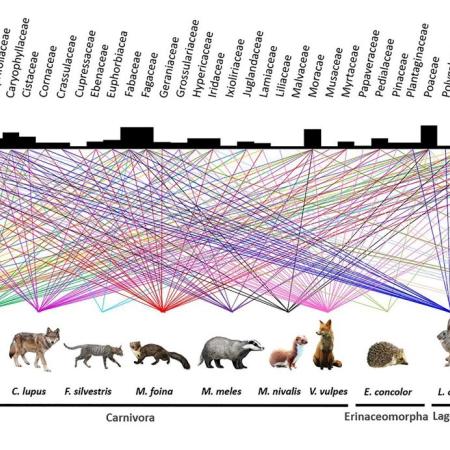
In Lebanon, very few organizations implement science-based solutions in fieldwork, and a lack of unified governance leaves restoration strategies fragmented and uncoordinated. Local NGOs often carry out reforestation and ecosystem restoration without communication with ministries or other parties, making it difficult to create a cohesive, sustainable impact. With climate change posing serious threats to our biodiversity and ecosystems, we recognized a crucial need: reforestation must be more strategic, using plant species that attract wildlife and support natural regeneration, to build self-sustaining forests resilient to climate pressures.
Amid the financial crisis, political instability, and environmental challenges, we pressed forward. Collaborating with the Smithsonian Institution was a turning point; they guided us in customizing DNA metabarcoding techniques to analyze local ecosystems. Together, we developed a science-driven approach that would ensure our restoration efforts support both biodiversity and local wildlife interactions.
Despite the chaos, our team has become a hub for conservation research and genetic characterization of Lebanon’s biodiversity. Seeing other organizations and local stakeholders recognize the importance of a science-based approach has been inspiring. Today, we are not just planting trees; we are cultivating sustainable ecosystems and laying the groundwork for a resilient environmental future in Lebanon.
